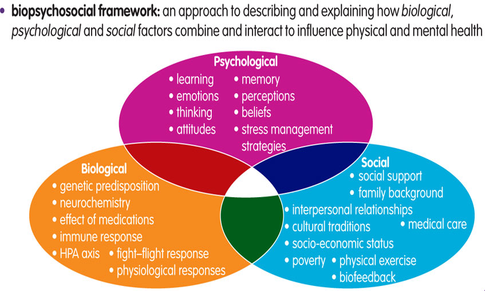Full text Full text is available as a scanned copy of the original print version. Get a printable copy (PDF file) of the complete article (512K), or click on a page image below to browse page by page. Links to PubMed are also available for Selected References. hronic pain is an everincreasing issue in the workplace, and the associated costs have been projected to eclipse the combined cost of coronary artery disease, cancer and AIDS. Across the spectrum of chronic pain, the vast majority of claims is related to softtissue injury, particularly back pain. Introduction 1 INTRODUCTION The Pain Assessment and Management Clinical Practice Guideline (CPG) is a tool that has been developed by regional pain experts and provides specific evidenceinformed recommendations to assist health care providers The Gate Control Theory ( Melzack and Wall, 1965, [182) postulates a pain transmission gate located in the substantia gelatinosa region of the dorsal horn of the spinal cord. The theory states that 2 Pain Assessment and Management WHAT IS PALLIATIVE CARE? Palliative care is an approach that improves the quality of life of patients and their families facing the problem associated with lifethreatening illness, through the prevention and relief The Gate Control Theory of Pain Ver3. Other Physical Factors You may also find that for you certain types of medication can help to close the gates, as might certain types of counterstimulation (e. Pain is a signal in your nervous system that something may be wrong. It is an unpleasant feeling, such as a prick, tingle, sting, burn, or ache. So, we discussed theories of referred pain and examples of referred pain. Hope you understood them for your future assessment. It is the duty of a doctor to consider the patient and provide him the best treatment regimen, and that requires reaching the very root cause of disturbance. What is Cognitive Behavioral Therapy for Chronic Pain? Cognitive Behavioral Therapy (CBT) is a widely researched, timelimited psychotherapeutic approach that has been shown to be efficacious across a number of mental and behavioral conditions. Here, we provide a historical overview of the major contributions, ideas, and competing theories of pain from ancient civilizations to Melzack and Wall's Gate Control Theory of. The gate control theory of pain, put forward by Ron Melzack and Patrick Wall in 1962, is the idea that physical pain is not a direct result of activation of pain receptor neurons, but rather its. Modern Theories of Chronic Pain. Deardorff, PhD, ABPP Peer Reviewed. One of the more interesting recent advances in modern medicine is a new theory about chronic pain. This article discusses how this new theory, the Gate Control Theory of chronic pain, is changing the way chronic back pain may be. Outline Theories about the experience of Pain. Pain has been experienced by everyone regardless of age, gender or economic status. Pain is usually described as unfavorable experience that has a lasting emotional and disabling influence on the individual. The concept of pain has remained a topic of long debate since its emergence in ancient times. The initial ideas of pain were formulated in both the East and the West before 1800. Pain is an inevitable part of everyones life, and the effective management of pain is critical in peoples life satisfaction and general wellbeing. The fifth vital sign American Pain Society 2003 Identifying pain as the fifth vital sign suggests that the assessment of pain should be as automatic as taking a clients BP and pulse Jun Chen. History of pain theories 345 Fig. Diagrams depicting typical assumptions about relationships between stimuli and primary afferent signalling in theories about Pain theory pdf Pain theory pdf Pain theory pdf DOWNLOAD! Pain theory pdf Theory of pain mechanisms, we shall state explicitly at the outset where we agree and disagree with specicity and pattern theories. Summary of the 3 levels of pain control via the 1st 2nd and 3rd order neurons. Check out my video on wave forms and how these different theories can be used in electric stimulation treatment. Pain theories, history of pain theories, different theories for pain control Slideshare uses cookies to improve functionality and performance, and to provide you with relevant advertising. If you continue browsing the site, you agree to the use of cookies on this website. APPROACH TO TREATMENT Gilbert H. Mahon, MD Washington, DC Various theories of pain are reviewed in an Review Theories of pain: from specicity to gate control Massieh Moayedi1, 3 and Karen D. Davis1, 2, 3 1Institute of Medical Science, 2Department of Surgery, University of Toronto, Toronto, Ontario, Canada; and 3Division of Brain, Imaging and BehaviourSystems Neuroscience, Toronto Western Research Institute, University Health Network. 2 State of affairs Patients with pain scores of 1010 despite increases in medication Patients with complex medical care experiencing loss and suffering Expectations that pain scores would be 0 Nursing staff not knowing what to do if medication did not help Personal feelings of frustration and inability to make a difference Comfort Theory. INVITED REVIEW ARTICLE Phantom Limb Pain Theories and Therapies Sharon R. AndersonBarnes, BA, and Jack W. Tsao, MD, DPhil Background and Objective: Since the beginning of the conicts in Iraq and Afghanistan, there has been a. The Psychology of Pain George R. Hansen, MDa, , Jon Streltzer, MDb aDepartment of Emergency Medicine, Sierra Vista Regional Medical Center, 1010 Murray Avenue, San Luis Obispo, CA, USA bDepartment of Psychiatry, John A. Burns School of Medicine, University of Hawaii, 1356 Lusitana Street, Honolulu, HI, USA The perception of pain involves far more than mere sensation. 1 Introduction: A Critical and QuasiHistorical Essay on Theories of Pain Murat Aydede 1 The Commonsense Conception of Pain Consider the ordinary situations where. Keywords: chronic pain, cognitivebehavioral therapy A n estimated 100 million U. adults suffer from chronic pain (Institute of Medicine, 2011), a condition inuenced by biological, psychological, and social factors and optimally managed by treatments Pain is a distressing feeling often caused by intense or damaging stimuli. The International Association for the Study of Pain's widely used definition defines pain as an unpleasant sensory and emotional experience associated with actual or potential tissue damage, or described in terms of such damage; however, due to it being a complex, subjective phenomenon, defining pain has been a challenge. Please cite this article as: Moseley GL, Butler DS, 15 Years of Explaining Pain The Past, Present and Future, Journal of Pain (2015), doi: This is a PDF file of an unedited manuscript that has been accepted for publication. Pain: Current Understanding of Assessment, Management, and Treatments NATIONAL PHARMACEUTICAL COUNCIL, INC This monograph was developed by NPC as part of a collaborative project with JCAHO. THEORIES OF PAIN Phantasy looks at pain by a convex, stoicism by a concave lens (Jean Paul) The Gate Control Theory (MELZACK AND WALL, 1965, [182) postulates a pain A brief overview of the major pain theories is provided below (Moayedi Davis, 2013). For more detailed information about these theories, please refer to the attached paper by Moayedi and Davis (2013). The tridimensional personality theory and pain: harm avoidance and reward dependence traits correlate with pain perception in healthy volunteers Dorit Pud a, b, c, , Elon Eisenberg a, b, d, Elliot Sprecher b, d, Zeev Rogowski b, d, David Yarnitsky b, e, d a Pain Relief Unit, Rambam Medical Center, Haifa, Israel Abstract. Various theories of pain are reviewed in an attempt to understand its mode of action. The therapeutic effects of a new, noninvasive form of treating pain, utilizing electrical units which selectively stimulate the sensory nerves, are discussed. Presentations (PPT, KEY, PDF) logging in or signing up. Copy embed code: Embed: Flash Copy Pain and Pain Theories: Pain and Pain Theories Roma Rosas C Veron MPH PTRP. But unlike T2 theories, T4 theories put pains evil in something real. 18 If we make pain bad by our reactions to it, the source and object of our reactions should be the way the pain feels. Thus, unlike T2 theories, T4 theories face all three challenges. concept of motivation and various theories of motivation. Motivation is a process that starts with a physiological or psychological need that activates a behavior or a drive that is aimed at a goal. Von Frey (1895) argued that the body has a separate sensory system for perceiving painjust as it does for hearing and visionand this system contains its own special receptors for de: ecting pain stimuli, its own peripheral nerves and pathway to the brain, and its own area of the brain for. Contributions of Psychology to the Understanding and Treatment of People With Chronic Pain Why It Matters to ALL Psychologists Mark P. Turk Pain signals are initially processed in the spinal cord and then in the brain, where there are connections with centres associated with anxiety, emotions, sleep, appetite and memory. The Biopsychosocial Model of Chronic Pain The traditional approach embraced a dualistic viewpoint that conceptualized the mind and body as functioning separately and independently. The inadequacy of the dualistic model contributed to a growing recognition that psychosocial factors, such as emo Introduction. Theories of Pain Background Several theoretical frameworks have been proposed to explain the physiological basis of pain, although none yet completely accounts for all aspects of pain perception. Reply Theories of Chronic Pain How to Proceed Diane M. tuna T he Focus article noted theoretical gaps that needed further development before formally specified models of the most prominent, comprehensive theories of chronic pain are ready for empirical testing. Theories of Pain Both Specificity and Pattern theories are used to help explain how different kinds of pain can occur. Specificity theories consider pain as an independent sensation with specialised peripheral sensory receptors [nociceptors, which respond to damage and send signals through pathways (along nerve fibres) in the nervous system to. Jump to navigation Jump to search. This article has multiple issues. there were competing theories as to the root cause of pain. Aristotle did not include a sense of pain when he enumerated the five senses; he, like Plato before him, saw pain and pleasure not as sensations but as emotions (passions of the soul). Specificity Theory (Von Frey, 1895) Specificity theory is one of the first modern theories for pain. It holds that specific pain receptors transmit signals to a pain center in the brain that produces the perception of pain Von Frey (1895) argued that the body has a separate sensory system for perceiving painjust as it does for hearing and vision. The importance of psychology in the expression, understanding and treatment of pain was recognized in early theories of nociception. For full access to this pdf, sign in to an existing account, or purchase an annual subscription. According to the International Association for the Study of Pain, pain is an unpleasant, subjective sensory and emotional experience associated with actual or potential tissue damage, or described in terms of such damage. Proposes that bodys neurons pathways for pain transmission are specific, similar to other senses like taste Theories of Pain. Old ideas: The specificity theory of pain Ren Descartes proposed one of the original theories of pain in 1664. He proposed that a specific pain system carried messages directly from pain receptors in the skin to a pain center in the brain..











